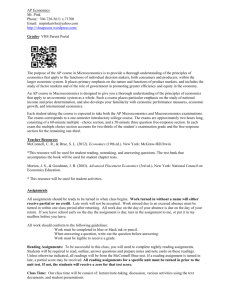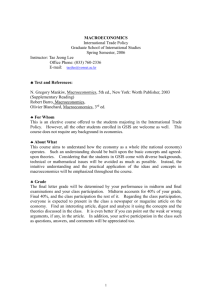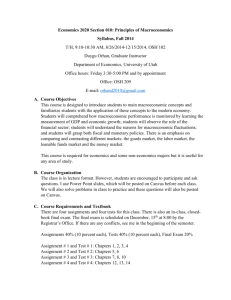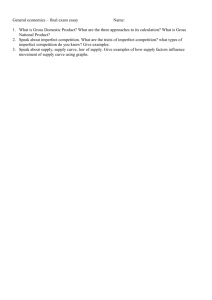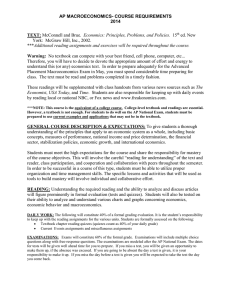St_ Thomas University_ Principles of Macroeconomics Syllabus
advertisement
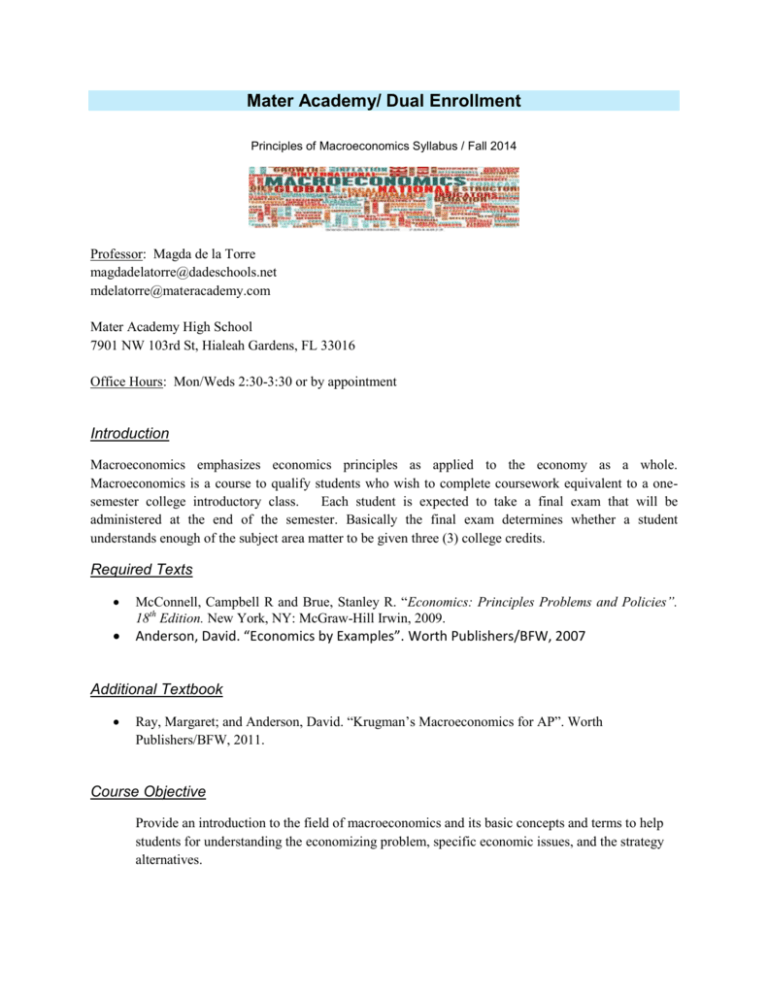
Mater Academy/ Dual Enrollment Principles of Macroeconomics Syllabus / Fall 2014 Professor: Magda de la Torre magdadelatorre@dadeschools.net mdelatorre@materacademy.com Mater Academy High School 7901 NW 103rd St, Hialeah Gardens, FL 33016 Office Hours: Mon/Weds 2:30-3:30 or by appointment Introduction Macroeconomics emphasizes economics principles as applied to the economy as a whole. Macroeconomics is a course to qualify students who wish to complete coursework equivalent to a onesemester college introductory class. Each student is expected to take a final exam that will be administered at the end of the semester. Basically the final exam determines whether a student understands enough of the subject area matter to be given three (3) college credits. Required Texts McConnell, Campbell R and Brue, Stanley R. “Economics: Principles Problems and Policies”. 18th Edition. New York, NY: McGraw-Hill Irwin, 2009. Anderson, David. “Economics by Examples”. Worth Publishers/BFW, 2007 Additional Textbook Ray, Margaret; and Anderson, David. “Krugman’s Macroeconomics for AP”. Worth Publishers/BFW, 2011. Course Objective Provide an introduction to the field of macroeconomics and its basic concepts and terms to help students for understanding the economizing problem, specific economic issues, and the strategy alternatives. Course Outline Module 1: Introduction to Economics The course provides instruction in basic economic concepts. Support text: McConnell and Brue, Economics 18th Ed, Chapters 1, 2 and 3 A. Scarcity: Explain why scarcity is at the core of economic thought. Discuss the theory of needs of Maslow and Alderfer as an explanation for unlimited needs versus limited resources. The factors of production as the inputs necessary to satisfy needs. B. Opportunity Cost and choice: Define and compute it. Why can it never be avoided? C. Production Possibilities: Construct and interpret production possibilities schedules, and graphs; relate production possibilities curves to the issues of scarcity, choice and opportunity cost. Why are most PPCs bowed out? → Introduce the law of diminishing returns that implies increasing marginal cost of production. D. Specialization and Comparative Advantage: Define and calculate absolute and comparative advantages for production exchange. E. Functions of Any Economic System 1. How do different Economic Systems answer the questions: What to produce? How to produce? For whom to produce? 2. Compare different economics systems, and define ways societies determine allocation, efficiency, and equity. Module 2: Demand, Supply, and Price Determination The course provides instruction on national income and price determination. A. Demand: Define and illustrate demand through schedules and graphs. 1. Examine the inverse relationship existing between quantity demanded and price. Evaluate the Law of Demand. Focus on diminishing marginal utility. 2. Distinguish between change(s) in quantity demanded and change(s) in demand. 3. Identify and explain the variables that cause a change in demand. 4. Illustrate graphically a change in demand versus a change in quantity demanded. B. Supply: Define and illustrate supply through schedules and graphs. 1. Examine the direct relationship existing between quantity supplied and price. Evaluate the Law of Supply. 2. Identify and explain the variables that cause a change in supply. 3. Along the line or the line shifts? Illustrate graphically a change in supply versus a change in quantity supplied. C. Equilibrium Price and Quantity: Define and illustrate equilibrium through schedules and graphs. 1. Define and illustrate surpluses and shortages. 2. Define the effects of surpluses and shortages on prices and quantities. 3. Interpret the effects of a price floor and price ceiling on equilibrium price and quantity. 4. Introduction to market failures: lack of competition, externalities, and public goods. Module 3: The Gross Domestic Product and National Income. Concepts provides instruction in measurements of economic performance Support text: McConnell and Brue, Economics 18th Ed, Chapters 4, 24 and 26 Section I: Outline of the U.S. economy: private and public sectors A. The Role of Households in the Economy 1. Households as income receivers: functional and personal distribution of income. 2. Households as spenders: The distributions of expenditures B. B. Private and Public Sectors C. Business Population: Forms of businesses, the Principal-Agent problem. Functional distribution of income D. Public Sector: The Role of the Government. The Circular Flow Revisited. E. Measuring GDP, Four-Sector Circular Flow Model, and Flow Versus Stock 1. Expenditure approach [C+I+G+(X-IM)] 2. Income approach (W+I+R+P) F. What the GDP does not include: Nonmarket transactions, distribution, kind and quality of products. Compare GDP with other indexes of economic performance such as HDI (Human a. Development Index) G. Changing Nominal GDP (NGDP) to real GDP (RGDP). How and why? H. Other national accounts: net national product (NNP), national income (NI), personal income (PI), and disposable income (DI). Section I: Business Cycles and Instability: Unemployment A. Economic Growth: The Trend. B. Deviations from the Trend: Business Cycles. Phases and causation. C. Unemployment: 1. Definition and Measurement 2. Types: seasonal, frictional, structural, cyclical. Which affect the unemployment rate? D. Full Employment: What is it? What are the implications if achieved? E. The GDP Gap: Explaining lost potential and relate it to employment. Section III: Inflation A. The meaning and measurement of Inflation B. The Consumer Price Index (CPI) and How It Is Computed C. Problems with the CPI D. Other indexes and what information they provide: Producer Price Index E. Consequences of Inflation: shrinking incomes, changes in wealth, effect on interest rates. F. Demand- Pull and Cost-Push Inflation G. Deflation: causes and consequences. Module 4: Macroeconomic Models and Fiscal Policy Support text: McConnell and Brue, Economics 18th Ed, Chapters 27, 28, 29 and 30 Section I: Basic Macroeconomic Relationships and the Aggregate Expenditures Model A. Consumption and Savings. Analysis of the functions. Marginal Propensities to Consume and Save B. Savings and Investment. The role of the Interest Rate. C. Changes in the consumption function D. Changes in the Investment Demand 1. Expectations 2. Technological change 3. Capacity utilization 4. Investment as an Autonomous Expenditure Section II: The Aggregate Expenditure Model A. The components of the Aggregate Expenditure. B. Graphing the Aggregate Expenditure Function. C. Equilibrium in the Aggregate Expenditures Model D. Government Spending and How It Affects Aggregate Demand: the Spending Multiplier Section III: The Aggregate Demand and Aggregate Supply Model (AD-AS) A. Aggregate Demand Curve: Reasons for Its Shape 1. Real balances effect 2. Interest rate effect 3. Net export effect B. Non-price Determinants of Aggregate Demand. Reasons for shifts of Aggregate Demand C. Aggregate Supply Curve: Reasons for its shape 1. Classical View - Long term view 2. Keynesian View – Short term view D. Non-price Determinants of Aggregate Supply 1. Input prices: National Resources, Imported Resources and Market Power 2. Productivity 3. Legal Institutional Environment. E. Macroeconomic Equilibrium. AD-AS Equilibrium: Graphical Analysis. Changes in AD and AS and its effects on prices and output F. The relationship between the Aggregate Demand Curve and the Aggregate Expenditures Model. Section IV: Fiscal Policy in the AD-AS Model A. B. C. D. E. F. Expansionary Fiscal Policy 1. Increased Government Spending 2. Changes in tax rates 3. Tax Reductions Contractionary Fiscal Policy 1. Decreased Government Spending 2. Changes in tax rates 3. Tax Increasing Balanced-budget multiplier Built-in Stabilizers Crowding-Out Effect The burden of the deficit over future expenditure Module 5: Money, Banking and Monetary Policy Support text: McConnell and Brue, Economics 18th Ed, Chapters 31, 32 and 33 Section I: The Money Market A. B. C. D. E. F. Functions of Money Money Supply Definitions 1. M1: most narrowly defined money supply 2. M2: adding near monies to M1 3. M3: adding large time deposits to M2 What stands behind money? Demand for money The Money Market The Federal Reserve and the Banking System Section II: Money and Banking A. B. How banks create money The monetary multiplier Section III: Monetary Policy A. B. C. The Balance Sheet of Central Banks Tools of Monetary Policy. Connections with latest monetary Operations. 1. Open Market Operations: Buying and Selling Securities. 2. Changes in the Reserve Ratio 3. Changes in the Discount Rate 4. Debate on the relative importance of each tool 5. Debate on the different targets the Fed can have The effects of monetary policy in the aggregate economy: graph and analyze 1. Effects on real GDP and on the Price Level 2. Easy and tight monetary policy: Analysis of the recent years 3. Problems of monetary policy: lags, changes in velocity, cyclical asymmetry 4. Effects of monetary policy on the Trade Balance Module 6: Fiscal and Monetary Policies Interaction in the Short Run and in the Long Run: Classical and Keynesian Views Support text: McConnell and Brue, Economics 18th Ed, Chapters 35 and 36 Section I: The long run analysis A. From short term to long term. Prices and wages flexibility. B. The long run aggregate supply curve. The extended AD-AS model. Graph and analyze. 1. Demand-pull inflation. 2. Cost-push inflation. 3. Recession Section II: The Inflation-Unemployment Relationship A. The Phillips Curve and Expectation Theory 1. The short-run Phillips Curve 2. The long-run Phillips Curve 3. Stagflation B. Rational expectations Theory. Can it work? C. Taxation and Aggregate Supply 1. Supply-side economics 2. Support and Criticisms of the Laffer curve Section III: The Macroeconomic Debate A. Classical-Keynesian Differences 1. Different Explanations for recession 2. Mainstream Keynesian Theory 3. Monetarist View 4. Real Business-Cycle View 5. Coordination Failures B. The Self-Correction Hypothesis C. Intervention: Rules or Discretion Section IV: The Debate on the Government Budget A. Key terms: Deficit, Surplus, and Debt B. Public debt: The Data C. The Deficit Debate: Concerns and Macroeconomic Justifications. Module 7: The International Economy. Comparative Advantage and International Trade Support text: McConnell and Brue, Economics 18th Ed, Chapters 37 and 38 Section I: International Trade A. International Trade Importance: Some Data B. Why trade? Comparative Advantages Analysis 1. Graphical Analysis 2. Gains from trade C. The Supply and Demand Model Analysis D. The Effect of Trade Barriers 1. Tariffs 2. Quotas E. Free Trade versus Protectionism. F. The WTO Section II: Balance of Payment, Trade deficits, and Exchange Rates A. The Balance of Payment Structure B. Trade Deficits and Surpluses C. The Current Market 1. Flexible Exchange Rates i. Graphical analysis ii. Advantages and Disadvantages 2. Fixed Exchange of Rates i. Advantages and Disadvantages 3. History of International Exchange-Rate Systems. Module 8: Growth and Productivity Support text: McConnell and Brue, Economics 18th Ed, Chapters 23, 25, and 39 Section I: Economic Growth A. Supply factors for Growth B. The importance of Demand and Efficiency C. Growth in the Production Possibilities Curve Model D. Growth in the long run AD-AS model E. Productivity as reflection of Growth Factors. What factors could increase productivity? 1. Technology 2. Capital 3. Education and Training – Human capital 4. Economies of scale and allocation F. Productivity changes in history G. Growth, development, and sustainability. Section II: Economics of Developing Countries A. A look at the Data. Rich, poor, and middle income countries. B. Obstacles for growth: the vicious circle of poverty C. The role of Government D. The role of development countries E. What can be done? 1. At the developed countries 2. From the developed countries. Grading Policy Class work 15% Homework 20% Quizzes 15% Tests 25% Final Exam 25% Academic Integrity Statement Students must observe the principles of academic integrity. It is not permissible to cheat, to formulate or falsify information, to submit the same academic work in more than one course without prior permission, to plagiarize, to receive unfair advantage. The grade for this course includes the judgment that the student’s work is free from academic dishonesty of any type. Violations or infractions will be reported to the Vice President for Student Affairs and may lead to failure of the course and other sanctions imposed by the College. Disability Services Statement Accommodations are available for students with disabilities; please visit the Counseling Center. Contact Information To contact Mrs. de la Torre: Please e-mail me at mdelatorre@materacademy.com . You can also call me at school and leave me a message. I will response you as soon as possible. Office Hours Every Tuesday and Thursday, after school, from 2:40 to 3:45 p.m. Mrs. De la Torre will be in her room. In any case Ms. de la Torre will be in her classroom every day after school for questions and/or extra help.

